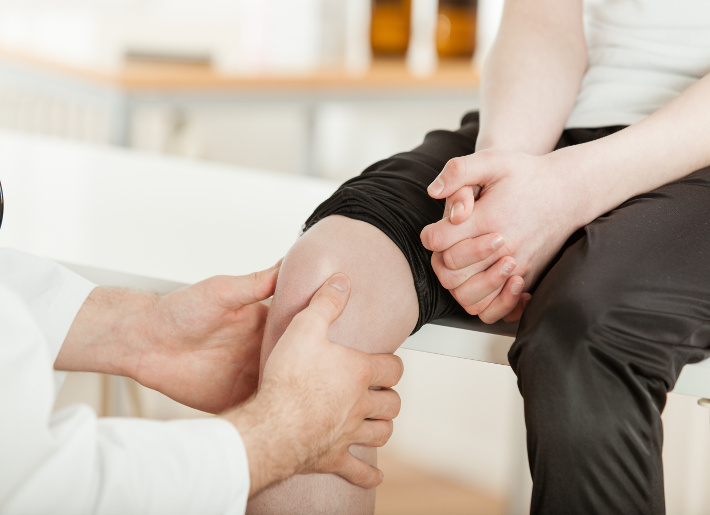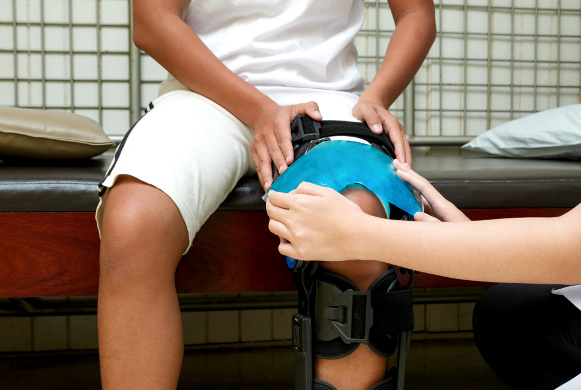Treating Juvenile Idiopathic Arthritis—A Naturopathic Perspective
What Is It?
 Juvenile idiopathic arthritis (JIA) can be
Juvenile idiopathic arthritis (JIA) can be
a painful condition for children and parents
alike, as they juggle
the everyday struggle while hoping for answers from the medical community.
JIA is the most common childhood rheumatic illness,
and is defined as a group of chronic arthritic diseases
which normally occur
in children under the age of 16.[1] JIA can present with morning stiffness, swelling, and tender joints, which force many children to opt out of extracurricular activities and can
leave them unable to bear weight for several hours each morning, heavily decreasing
their quality of life.[1]
JIA encompasses three types of onset: oligoarticular, polyarticular, and systemic, the
latter being the most aggressive and serious form. Oligoarticular JIA is the most
common form, present in 45% of patients, and is most often located in the knees or
ankles, with asymmetric involvement of joints and a total of four or fewer joints
involved.[1][2] Polyarticular JIA presents in about 25– 35% of cases and often has an
abrupt onset, affecting five or more joints both large and small.[1] Systemic JIA
presents in about 20–30% of patients, affecting both large and small joints with an
abrupt onset, high spiking fever, and a salmon-coloured rash.[1] The patient may have
generalized muscle weakness, pain, and tenderness, and will appear systemically ill,
often with an enlarged liver and spleen.[2]
Diagnosis
 If JIA is suspected, patients should immediately be
If JIA is suspected, patients should immediately be
referred to a pediatric rheumatologist and an ophthalmologist to
help monitor treatment and avoid detrimental outcomes, as eye involvement can lead
to permanent vision
loss and blindness.[1] Diagnosis is based on
a thorough history and clinical findings. The American College of Rheumatology criteria includes the presence of objective arthritis symptoms for at least six weeks in at least one joint in a patient under 16 years old, in the absence of other sources of juvenile arthritis.[1]
Clinical evaluation must determine the joints to be arthritic, which requires evidence
of swelling, effusion, or two of the following: warmth, tenderness, pain on passive
range of motion, or a limited range of motion.[1] There are no specific lab tests to
confirm a diagnosis of JIA; however, some tests that can be done which can help to
monitor prognosis include a complete blood count, inflammatory markers (CRP, ESR),
liver function tests, assessment of kidney function, ultrasound, CT, and MRI.[1][2]
Prognosis
Advances in treatment as well as the introduction of intra-articular steroids and other
medications has dramatically improved the prognosis for children with arthritis.[2]
Poor long-term outcomes have been associated with RF-positive arthritis, active
systemic disease, and symmetrical disease.[2] Complete remission criteria
according to the American College of Rheumatology includes no inflammatory joint
pain, morning stiffness, fatigue, synovitis, progression of damage, or elevations in
ESR and CRP.[2] Most children affected by oligoarticular disease have eventual
permanent remission; however, a small number of children progress to persisting
polyarticular disease.[2] Anterior uveitis (inflammation of the middle layer of the eye)
is seen in as many as 20% of children with JIA, and as this is typically asymptomatic
at onset, regular screening by an ophthalmologist is critical.[2] Systemic onset of JIA
can result in a rare but lifethreatening condition known as macrophage activation
syndrome, in which all three blood lines become decreased, leading to extremely low
blood pressure and central nervous system disease.[2]
Risk Factors and Genetic Links
Although the etiology is widely unknown, there are a few genetic associations and
associated disorders including ankylosing spondylitis, psoriatic arthritis, inflammatory
bowel disease, Sjögren syndrome, SLE, and mixed connective tissue disease.[1]
Environmental triggers in a genetically susceptible individual for developing JIA can
include psychological stress, abnormal hormones, joint trauma, and bacterial or
viral infections (influenza, adenovirus, mumps, rubella, Epstein-Barr virus, and
mycobacterial infection).[1]
Treatment
Treatment Goals
A team-based approach to treatment can be beneficial for creating the best outcomes
and quality of life for the patient, and can include pharmacologic therapy, psychosocial
interventions, nutritional and supplement therapy, physical therapy, academic
counselling,and physical therapy.[2] Treatment goals are relieving pain and
inflammation, preserving joint function, preventing further progression of disease,
maintaining normal growth and development, and preserving a normal lifestyle.[2]
Conventional Treatment
Treatment therapy is determined by the severity of disease activity, and success of
therapy is monitored with repeated physical examinations and history taking.[2] First-
line treatment is methotrexate, with 70–80% of people experiencing a 30%
improvement in symptoms.[1] Methotrexate may slow the progression of damage;
however, it may cause bone-marrow, lung, liver, or kidney toxicity, along with nausea,
vomiting, mouth sores, loss of appetite, hair loss, and fatigue.[1][3] NSAIDs are also
utilized for their anti-inflammatory and analgesic properties; however, long-term side
effects can include stomach pain and heartburn, stomach ulcers, allergic reactions,
and a tendency to bleed more.[1] Sulfasalazine, hydroxychloroquine, and leflunomide
are alternative drugs used when methotrexate is not effective or limited by adverse
effects; however, irreversible retinal damage has been reported in patients on
hydroxychloroquine for long periods of time.[1] Prednisone is reserved for patients
that are affected by systemic disease, or as a way to begin patients on drug therapy
at the start to try and control the disease.[1] A small number of patients with severe
JIA opt for surgical options, which can include a joint replacement, synovectomy, and
soft tissue release.[1]
Naturopathic Treatment
Naturopathic medicine can help to bridge the gaps in treatment and help increase
patient comfort, while decreasing medication use to the lowest effective dose,
through reducing pain and inflammation and replenishing nutrient deficiencies.
Calcium and Vitamin D
 A randomized controlled trial
A randomized controlled trial
(RCT) investigated
the role of calcium
in supporting
children with
juvenile rheumatoid
arthritis.[4] Steroid
use in JIA is known
to decrease bone
mineral density,
reduce the
absorption of
calcium, and
increase fracture
risk; however, children with JIA are also reported to have a low bone mineral density independent of steroid use, and approximately 15–26% suffer from fractures before adulthood.[5] Patients in the RCT were given 1000 mg of calcium with 400 IU vitamin
D, or a placebo with 400 IU vitamin D, and results were that adding calcium had a
significant benefit on increasing total body bone mineral density.[4]
Omega-3 Fatty Acids
In another RCT, 2 g/d omega-3 fatty acids given to children with JIA for 12 weeks
showed a significant improvement in the number of swollen joints, juvenile arthritis
disease activity scale, childhood health assessment questionnaire, and inflammatory
mediators, and decreased the daily NSAID requirements.[6] Decreasing NSAID
requirements was also effective in reducing side effects experienced by the
patient.[6] Patients can also be educated as to how to consume more fish high in
omega-3 fatty acids including salmon, trout, mackerel, sardines, and fresh tuna.[7]
Dietary Changes
Patients should be encouraged to consume diets rich in fruits, vegetables, nuts,
seeds, and whole grains, and low in animal fats and animal protein.[1] Avoiding
common and individual allergens will also be beneficial to reducing overall
inflammation.[1] Parents can encourage their children to avoid refined sugars,
processed foods, white breads, pasta, and cereals, and consume higher-protein
sources with each meal including nut butters, hummus, and eggs.[6]
Physical Therapy
 Physical activity should
Physical activity should
be encouraged, along with the application of both hot and cold
packs in order to decrease joint pain
and stiffness.[1] The application of hot
packs should be used
to stimulate blood
flow, relax muscles,
and decrease pain, followed by cold packs which can decrease swelling, stiffness,
and associated
pain.[5]
Massage therapy performed by the patient’s parents for 15 minutes a day resulted
in an immediate reduction in cortisol levels and anxiety, and an increased
participation in physical activities.[5]
Final Thoughts
A holistic approach needs to be taken when evaluating autoimmune disease and
inflammatory disorders in order to have a long-term positive impact on a patient’s
quality of life.
References
1. Mayo Clinic. Juvenile idiopathic arthritis. · https://www.mayoclinic.org/diseases-
conditions/juvenile-idiopathic-arthritis/symptoms-causes/syc20374082 · Updated
2017-12-20.
2. Medscape. Juvenile idiopathic arthritis. · https://emedicine.medscape.com/article/
1007276-overview · Updated 2016-10-06 · Accessed 2017-11-14.
3. Killeen, O. “In juvenile idiopathic arthritis, is folate supplementation effective
against methotrexate toxicity at the expense of methotrexate’s efficacy?” Archives
of Disease in Childhood. Vol. 91, No. 6 (2006): 537–538.
4. Lovell, D., et al. “A randomized controlled trial of calcium supplementation to
increase bone mineral density in children with juvenile rheumatoid arthritis.”
Arthritis & Rheumatism. Vol. 54, No. 7 (2006): 2235–2242.
5. The RACGP JIA Working Group. Clinical guideline for the diagnosis and
management of juvenile idiopathic arthritis. South Melbourne: The Royal
Australian College of General Practitioners, 2009, 39 p, ISBN 978-0-86906-
298-2. Available from http://www.ipts.org.il/_Uploads/ dbsAttachedFiles/cp119-
juvenile-arthritis.pdf · Accessed 2017-11-14.
6. Gheita, T., et al. “Omega-3 fatty acids in juvenile idiopathic arthritis: Effect on
cytokines (IL-1 and TNF-α), disease activity and response criteria.” Clinical
Rheumatology. Vol. 31, No. 2 (2011): 363–366.
7. JIA at NRAS. Diet and JIA. · http://www.jia.org.uk/diet-and-jia · Published
2015-11-05 · Accessed 2017-11-14.
 Dr. Laura Pipher, ND
Dr. Laura Pipher, ND
Laura is a naturopathic doctor in Ontario. She is passionate
in helping others live their best lives and reach all of their
goals through sustainable and realistic treatments.

 Stores
Stores